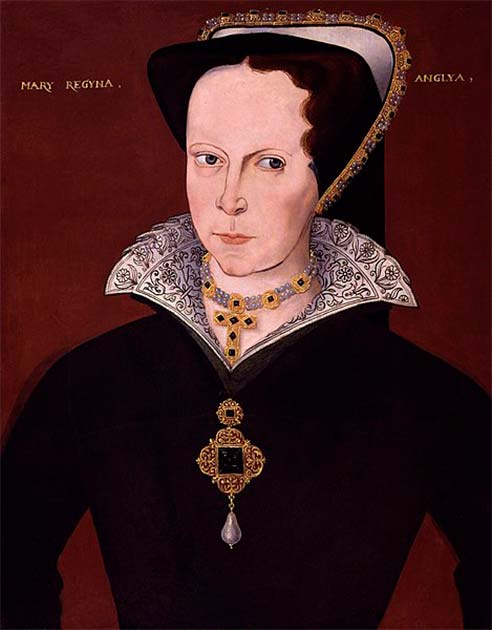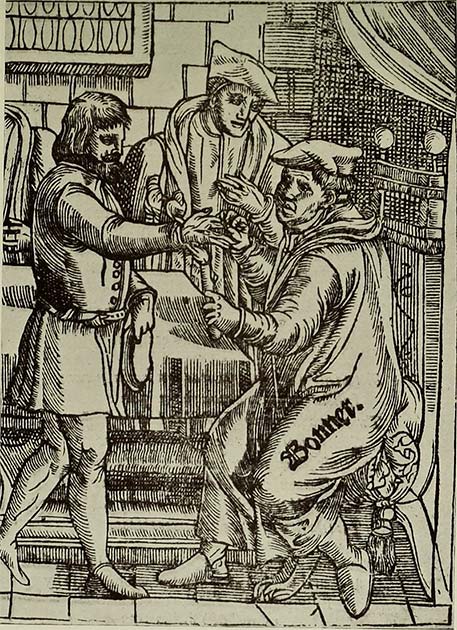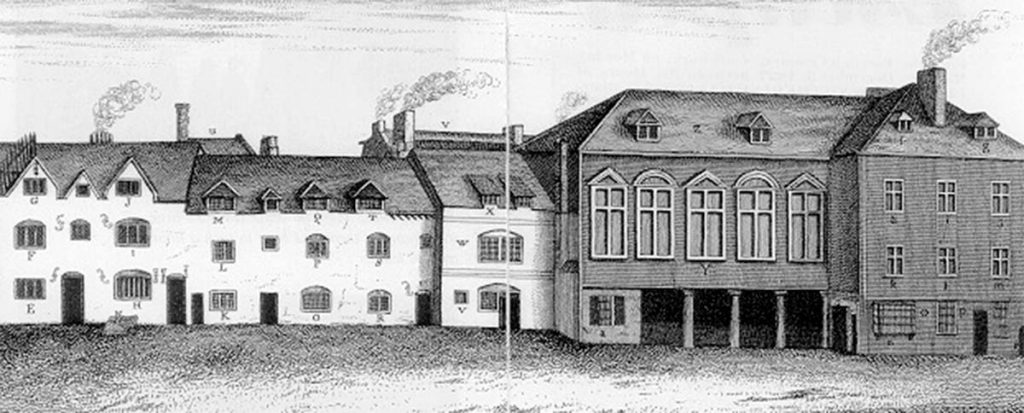The English Reformation was a tumultuous era during which religious convictions clashed and power shifted almost constantly. In the heart of this religious upheaval stood Edmund Bonner, the enigmatic Bishop of London.
Revered by some and reviled by others, Bonner’s name became synonymous with persecution and zealotry. As a staunch defender of Catholicism, he sought to extinguish the flames of Protestantism and restore the authority of the Catholic Church. His actions during the reign of Queen Mary I earned him infamy, but his ultimate fate would be shaped by the winds of change that swept across the English landscape.
Edmund Bonner and His Crimes
Born in 1500, Edmund Bonner was an incredibly influential figure during the English Reformation, serving as Bishop of London from 1539 to 1549 and again from 1553 to 1559. Today he is primarily remembered for his role in persecuting Protestant reformers under England’s Catholic Queen Mary I, known as Bloody Mary.
But interestingly, before he made a name for himself killing Protestants, he actually played a key role in separating England from Rome during the reign of Mary’s father, Henry VIII. It was Bonner who the King sent to the Vatican to argue for his divorce, and he stayed loyal to the King after his split from the Catholic Church.
However, unlike other religious figures involved in the English Reformation, Bonner stayed loyal to Catholicism. It was only after King Henry VIII died on 28 January 1547 Bonner’s views began to change.

He started to put his loyalty to his religion ahead of his loyalty to the Royal family. This shift in loyalty only hardened as he became increasingly enraged by the reforms being brought in by Protestants like Edward Seymour, 1st Duke of Somerset, and Archbishop Thomas Cranmer.
Bonner’s antagonism towards Protestantism landed him in jail twice during the reign of Edward VI, Bloody Mary’s predecessor. He was first imprisoned in 1547 but quickly wormed his way out by apologizing to the King.
He was then imprisoned again on 7 February 1550 after being found guilty of breaking religious laws and failing in his duties. He stayed in prison until Mary came to power in 1553.
- Papal Resignation and Papal Murder: Popes Celestine V and Boniface VIII
- Sir Walter Raleigh: Why was Elizabeth I’s Favorite Courtier Executed?
As soon as Queen Mary was crowned Bonner was released and once again made the Bishop of London. Mary was a die-hard Catholic and she made it his job to restore Catholicism to the land and submit once again to papal jurisdiction (despite his role in severing it in the first place).
Mary believed that religious dissidents (aka Protestants) would be best dealt with by ecclesiastical tribunals rather than by civil power. This meant that Bonner was essentially given free rein to deal with dissidents however he wished. He chose a stick rather than a carrot approach, earning him the name “Bloody Bonner.” He carried out:
1. Heresy Trials and Executions: He presided over heresy trials where those accused of holding Protestant beliefs were prosecuted. He used this position to condemn prominent figures of the English Reformation who he’d fallen out with in the preceding years. Men like Thomas Cranmer, Hugh Latimer, and Nicholas Ridley were all sentenced to death. Their deaths were not pleasant, they were burned at the stake for heresy.
2. Suppression of Protestantism: To be fair, Tudor England wasn’t exactly known for religious freedom, but Bonner took it to new heights. He ordered the removal of Protestant texts and images from churches and replaced them with Catholic equivalents. He also oversaw the enforcement of Catholic doctrines and rituals, including the use of Latin in religious services. Possession of Protestant texts and images was made a punishable offense.
3. Persecution and Imprisonment: Bonner authorized the imprisonment and torture of individuals suspected of being Protestant reformers. Many Protestants were held captive in the notorious Newgate Prison in London, often subjected to harsh conditions and mistreatment.

Bonner’s actions contributed to the atmosphere of fear and persecution that characterized the reign of Queen Mary I. Official numbers vary but between 250- 320 people are thought to have been tried and burnt at the stake. Countless others died during their incarceration due to the grim conditions.
4. Enforcement of Marian Religious Policies: Bonner was a key enforcer of Queen Mary I’s religious policies, which aimed to restore Catholicism as the official religion of England. As such he worked diligently to tear down all the changes made in recent years and he actively supported the revocation of Protestant reforms implemented by Henry VIII and Edward VI, and worked to reinstate Catholic practices and doctrines.
Motives
One might wonder why a supposedly pious man would so ruthlessly pursue the imprisonment and persecution of other Christians. Well, his motivations can only be understood within the context of his strong Catholic beliefs and his loyalty to the Catholic Church.
- Sir Francis Walsingham: Who was Queen Elizabeth’s Spymaster in Chief?
- The Duke of Buckingham: Was Dumas’s Hero also James I’s Lover?
Bonner was a fervent, fire-brand Catholic who was utterly devoted to the teachings and doctrines of the Catholic Church. There was no room for doubt in his mind and he saw Protestantism as a heretical deviation from the true faith.
He saw it as his duty, his mission from God, to combat and suppress what he saw to be false beliefs. Bonner believed that by eradicating Protestantism and restoring Catholicism, he was safeguarding the spiritual welfare of the people. In his eyes, he was the good guy.
Bonner was also loyal to the crown. He had once been one of Henry’s most loyal servants and his loyalty was renewed when Mary, a fellow staunch Catholic, was crowned. Mary was determined to return England to Catholicism and reverse the religious reforms implemented by her predecessors, particularly her father, Henry VIII, and her brother, Edward VI. Bonner’s actions can be seen as an expression of his loyalty to the queen and his commitment to implementing her religious policies.
The Fall Of Bloody Bonner
Unfortunately for Bonner, Mary’s reign was short-lived, and she was soon replaced by her sister, Elizabeth, a protestant. When Elizabeth was crowned in 1558, she made it clear she wished to pursue a religious settlement that aimed for religious moderation and tolerance in the country. There was no room in her church for Bloody Bonner.
He was quickly asked to resign his bishopric, but he replied that he would rather die than resign. In 1559 he was forcefully removed from his position and was replaced by a Protestant Bishop of London. On 20 April 1560, he was once again sent to Marshalsea prison.

Bonner spent the last nine years of his life imprisoned The Protestant Party spent that entire time trying to have Bonner and other Catholic figures like him executed on religious charges as well as high treason. They never got their way, but Bonner did die in prison. He died on 5 September 1569 and was quietly buried in St George’s, Southwark. He was still a high-profile enough figure that this burial was conducted in secret to avoid violent protests.
Edmund Bonner’s legacy remains a haunting reminder of the religious conflicts that defined the English Reformation. His fervent pursuit of Catholic orthodoxy, coupled with his relentless persecution of Protestants, left an indelible mark on history. While his actions were driven by his deep-seated religious convictions and loyalty to the Catholic Church, they also sparked outrage and resistance among those seeking religious reform.
Ultimately, Bonner’s fall from grace mirrored the shifting tides of religious and political power, as the ascension of Queen Elizabeth I relegated him to a life of arrest and obscurity. Edmund Bonner’s controversial tale serves as a poignant reminder of the price paid during an era of religious strife and the lasting impact of individual convictions on the course of history.
Top Image: Bloody Bonner takes a personal hand in punishing a heretic. Source: Unknown Author / Public Domain.